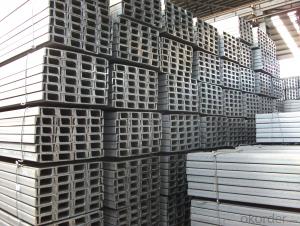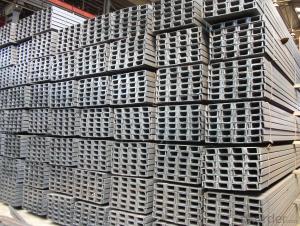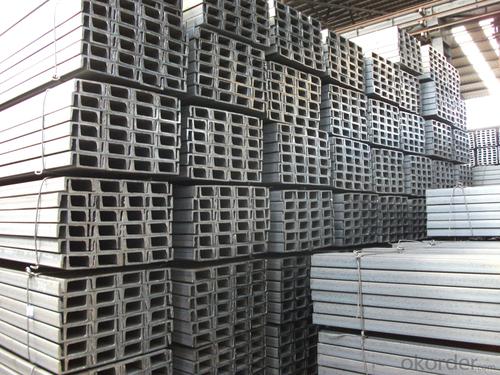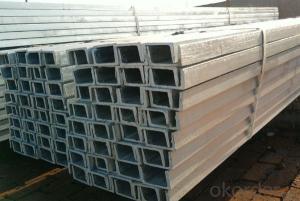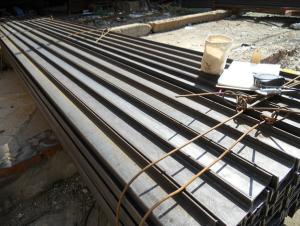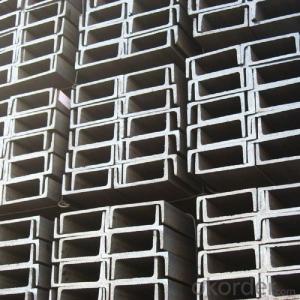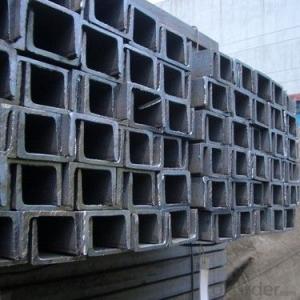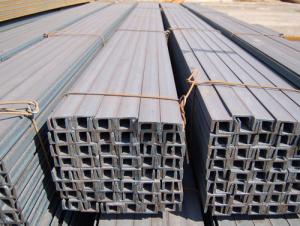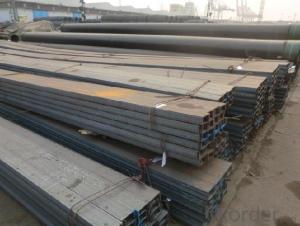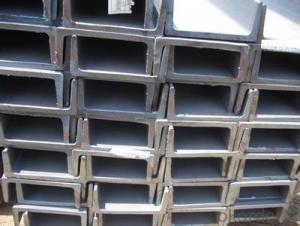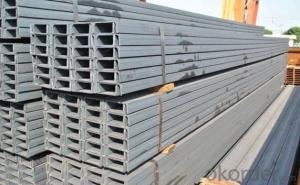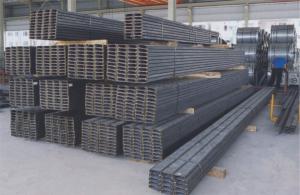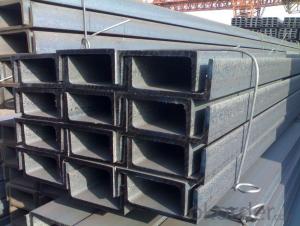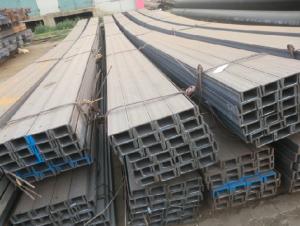U CHANNEL
- Loading Port:
- China Main Port
- Payment Terms:
- TT OR LC
- Min Order Qty:
- -
- Supply Capability:
- -
OKorder Service Pledge
OKorder Financial Service
You Might Also Like
Specifications of MS Channel:
1.We supply high quality MS Channel at reasonable price, including Chinese standard, Japanese standard and so on.
Standard | GB/JIS |
Material Grade | Q235,SS400 |
Technique: | Hot Rolled |
Sizes as per chinese standard: | 50*37*4.5mm - 300*89*11.5mm |
Sizes as per japanese standard: | 50*25*3mm – 200*80*7.5mm |
Length: | 6meter, 9meter, 12meter |
Note: 1.we are also competent to provide our customers other MS Channel based on other sizes according to customer’s requirements.
2. The length of our ms channel could be cut into other meters as per customer’s requirements. For example, the channel in 6meters could be cut into 5.8meters in order to be fit in the 20ft container.
2. The detailed sections of MS Channel as per GB standard.are shown in the table-1:
GB U CHANNEL | Standard | Sectional | Dimension |
| Mass: |
| (mm) | (mm) | (mm) | (mm) |
|
50X37 | 50 | 37 | 4.50 | 7.0 | 5.438 |
63X40 | 63 | 40 | 4.80 | 7.5 | 6.634 |
80x43 | 80 | 43 | 5.00 | 8.0 | 8.045 |
|
|
|
|
|
|
100x48 | 100 | 48 | 5.30 | 8.5 | 10.007 |
120x53 | 120 | 53 | 5.50 | 9.0 | 12.059 |
140x58 | 140 | 58 | 6.00 | 9.5 | 14.535 |
140x60 | 140 | 60 | 8.00 | 9.5 | 16.733 |
|
|
|
|
|
|
160x63 | 160 | 63 | 6.50 | 10.0 | 17.240 |
160x65 | 160 | 65 | 8.50 | 10.0 | 19.752 |
|
|
|
|
|
|
180x68 | 180 | 68 | 7.00 | 10.5 | 20.174 |
180x70 | 180 | 70 | 9.00 | 10.5 | 23.000 |
|
|
|
|
|
|
200x73 | 200 | 73 | 7.00 | 11.0 | 22.637 |
200x75 | 200 | 75 | 9.00 | 11.0 | 25.777 |
|
|
|
|
|
|
220x77 | 220 | 77 | 7.00 | 11.5 | 24.999 |
220x79 | 220 | 79 | 9.00 | 11.5 | 28.453 |
|
|
|
|
|
|
250x78 | 250 | 78 | 7.00 | 12.0 | 27.410 |
250x80 | 250 | 80 | 9.00 | 12.0 | 31.335 |
250x82 | 250 | 82 | 11.00 | 12.0 | 35.260 |
|
| |
|
|
|
280x82 | 280 | 82 | 7.50 | 12.5 | 31.427 |
280x84 | 280 | 84 | 9.50 | 12.5 | 35.823 |
280x86 | 280 | 86 | 11.50 | 12.5 | 40.219 |
|
|
|
|
|
|
300x85 | 300 | 85 | 7.50 | 13.5 | 34.463 |
300x87 | 300 | 87 | 9.50 | 13.5 | 39.173 |
300x89 | 300 | 89 | 11.50 | 13.5 | 43.883 |
Table-1
3. The chemical composition of HR Channel Steel according to Q235B is shown in Table-2.
Alloy No | Grade | Element(%) | ||||
C | Mn | S | P | Si | ||
Q235 | B | 0.12-0.20 | 0.3-0.7 | ≦0.045 | ≦0.045 | ≦0.3 |
Table-2
Note: we are able to present our customers relevant SGS test report for chemical composition of HR Channel Steel.
4. The mechanical property of HR Channel Steel according to Q235B is shown in Table-3-1 and Table-3-2
Alloy No | Grade | Yielding Strength Point(Mpa) | |||
Thickness(mm) | |||||
≦16 | >16-40 | >40-60 | >60-100 | ||
≧ | |||||
Q235 | B | 235 | 225 | 215 | 205 |
Table-3-1
Alloy No | Grade | Tensile Strength(Mpa) | Elongation After Fracture(%) | |||
| | Thickness(mm) | |||||
≦16 | >16-40 | >40-60 | >60-100 | |||
≧ | ||||||
G235 | B | 375-500 | 26 | 25 | 24 | 23 |
Table-3-2
Note: we are able to present our customers relevant SGS test report for mechanical property of MS Channel as customer’s request.
Applications of MS Channel:
The MS Channel can be applied to construction of warehouses, workshops, sport stadiums and car parks etc.The hot rolled channel steel belongs to carbon structural steel which is applied to in the field of construction and machinery.In details, the hot rolled channel steel is usually used for arch-itechtural structure, and they could be welded in order to support or hang a vari-ety of facilities. They are also usually used in combination with I beam. Generally,the hot rolled channel steel we supply must possess perfect welding property, riveting property and mechanical property and so on.
Package & Delivery of MS Channel:
1.The hot rolled channel steel will be packed in bundle with steel wire at each end of every bundle and color marking in order to help the customer to recognize his goods more easily at sight.
2. And the hot rolled channel steel could be loaded into 20ft or 40ft container, or by bulk cargo.If the weight of each bundle reaches more than 3.5 mt, the loading by break bulk cargo should be choosed.When the weight of each bundle reaches less than 3mt, the loading by container should be choosed.
3.As for the transportaion from mill to loading port, the truck will be usually used. And the maximum quantity for each truck is 40mt.
4.All in all, we could do in accordance with customer's request.
- Q: Are steel channels suitable for use in corrosive environments?
- Steel channels can be suitable for use in corrosive environments, depending on the type of steel used and the specific conditions of the environment. Stainless steel channels, for example, are highly resistant to corrosion due to the presence of chromium and other alloying elements. These channels are often used in industries such as chemical processing, marine, and food processing, where exposure to corrosive materials or environments is common. However, not all steel channels are equally suitable for corrosive environments. Carbon steel channels, for instance, are more susceptible to corrosion and may require additional protective measures such as coatings or regular maintenance to prevent rusting. In extremely corrosive environments, specialized alloys like duplex or super duplex stainless steel channels may be necessary for optimal corrosion resistance. Additionally, factors such as temperature, humidity, and the concentration of corrosive agents play a significant role in determining the suitability of steel channels in corrosive environments. Consulting with corrosion engineers or specialists can help in selecting the appropriate type of steel and protective measures to ensure the longevity and performance of steel channels in such environments.
- Q: What are the different methods of surface finishing for steel channels?
- Steel channels can be finished using various methods, each offering unique benefits and applications. Some commonly used techniques include: 1. Painting: Steel channels can be painted to achieve an appealing finish while also protecting against corrosion and environmental factors. Depending on specific requirements, epoxy, polyurethane, or enamel paints can be used. 2. Galvanizing: Coating steel channels with zinc through galvanizing provides excellent corrosion resistance, making it ideal for outdoor or harsh environments. Hot-dip galvanizing and electroplating are commonly employed for this purpose. 3. Powder coating: By applying powdered paint electrostatically and then heating it to create a durable finish, powder coating offers a wide range of color options, chip resistance, and durability. 4. Anodizing: Though typically used for aluminum, anodizing can also be employed for steel channels. This electrochemical process forms an oxide layer on the steel's surface, enhancing corrosion resistance and allowing for various dyeing options. 5. Plating: Plating involves depositing a thin layer of metals like chrome, nickel, or zinc onto steel channels. This technique enhances aesthetics, corrosion resistance, and can even improve hardness or lubricity. 6. Polishing: Steel channels can be polished using abrasives to create a smooth and glossy surface. This method is often utilized for decorative purposes or to enhance the visual appeal of stainless steel channels. Choosing the most suitable surface finishing method for steel channels depends on factors such as aesthetic requirements, corrosion resistance, durability, and cost-effectiveness. It is advisable to consult professionals and consider the specific application before making a decision.
- Q: What type of channel is used for the type of room with a span of 4 meters?
- The flexural strength of 10# steel in the distance is less than 50 cm, a span of 4 meters is safe.
- Q: What is the typical lifespan of steel channels?
- The typical lifespan of steel channels can vary depending on several factors including the quality of the steel used, the environment in which they are installed, and the level of maintenance they receive. However, on average, steel channels can have a lifespan ranging from 20 to 50 years. Steel channels are commonly used in construction and industrial applications due to their durability and strength. They are designed to withstand heavy loads and provide structural support. However, over time, steel channels may be subject to corrosion, wear and tear, and other forms of degradation. The lifespan of steel channels can be extended through regular maintenance and protective measures. This includes routine inspections, cleaning, and applying protective coatings or treatments to prevent corrosion. Additionally, proper handling, installation, and load management can also contribute to prolonging their lifespan. It is important to note that the specific lifespan of steel channels can vary based on the specific conditions they are exposed to. For instance, steel channels installed in coastal areas with high levels of saltwater exposure may experience accelerated corrosion and a shorter lifespan compared to those installed in more inland regions. To determine the expected lifespan of steel channels in a particular application, it is recommended to consult with structural engineers, manufacturers, or industry experts who can provide insights based on the specific requirements and conditions of the project.
- Q: What are the typical finishes available for steel channels?
- The typical finishes available for steel channels include hot-dip galvanized, powder coated, painted, and bare steel.
- Q: What are the different surface finishes available for painted steel channels?
- Painted steel channels come in a variety of surface finishes, each with its own purpose and aesthetic appeal. The most common finishes include: 1. Smooth finish: This is the standard and widely used finish for painted steel channels. It provides a sleek and polished appearance with a glossy surface. 2. Matte finish: For a more subdued and contemporary look, a matte finish is ideal. It offers a non-reflective surface and is often used to minimize glare. 3. Textured finish: Textured finishes add depth and dimension to the steel channels. This can be achieved through techniques like embossing or sandblasting, resulting in visually interesting and tactile textures. 4. Hammered finish: By creating small indentations on the surface, a hammered finish gives the steel channels a rustic and distinctive appearance, resembling hammered metal. 5. Patterned finish: Patterned finishes involve applying specific designs or patterns onto the channels. Techniques like stenciling or laser etching can be used to achieve intricate and eye-catching designs, allowing for endless customization possibilities. 6. Metallic finish: Adding metallic pigments to the paint creates a shiny and reflective surface. This luxurious finish is often used when a touch of elegance is desired. It's important to consider that the availability of these finishes may vary depending on the manufacturer or supplier of the steel channels. The choice of finish may also depend on the intended use and the desired overall aesthetic of the project.
- Q: Can steel channels be used for equipment enclosures?
- Yes, steel channels can be used for equipment enclosures. Steel channels provide structural stability and durability, making them suitable for housing and protecting equipment. They can be easily customized and adapted to accommodate various sizes and types of equipment. Additionally, steel channels offer excellent shielding against external elements and provide enhanced security for the enclosed equipment.
- Q: Are steel channels suitable for commercial construction projects?
- Yes, steel channels are suitable for commercial construction projects. They are widely used in the construction industry due to their high strength, durability, and versatility. Steel channels provide structural support, are resistant to fire and corrosion, and can be easily customized to meet specific project requirements. Additionally, steel channels offer cost-effective solutions for commercial construction, making them a popular choice among architects and builders.
- Q: Are steel channels cost-effective compared to other materials?
- Yes, steel channels are generally considered to be cost-effective compared to other materials. Steel is a widely available and relatively inexpensive material, making steel channels a cost-effective choice for various construction and manufacturing applications. Additionally, steel channels offer excellent strength and durability, allowing them to withstand heavy loads and harsh conditions. This durability translates to long-term cost savings as steel channels require less maintenance and replacement compared to other materials. Furthermore, steel is highly recyclable, making it an environmentally friendly option. While the initial cost of steel channels may be slightly higher compared to some other materials, the long-term cost-effectiveness and numerous advantages make steel channels a popular choice in various industries.
- Q: What are the common methods of joining steel channels together?
- Steel channels can be joined together using various methods, including welding, bolting, riveting, and adhesive bonding. Welding is a widely used technique for joining steel channels. It involves melting the edges of the channels and fusing them together using a welding rod or electrode. This creates a strong and permanent bond. Welding is particularly effective for thick steel channels, offering high strength and durability. Bolting, on the other hand, utilizes bolts, nuts, and washers. Holes are drilled through the channels, and bolts are inserted and tightened with nuts on the opposite side. Bolting is a versatile method that allows for easy disassembly and reassembly of the channels, making it suitable for applications requiring frequent maintenance or adjustments. Riveting, another method, employs metal rivets to connect steel channels. Holes are drilled through the channels, and a rivet is inserted and secured by hammering or pressing. Riveting creates a robust and permanent connection, commonly used in structural applications like bridges and buildings. Adhesive bonding involves the use of industrial-grade adhesives to join steel channels. The adhesive is applied to the surfaces of the channels, and pressure is applied for proper adhesion. While adhesive bonding can provide a strong and durable bond, it is crucial to choose the appropriate adhesive based on the specific steel and application requirements. The selection of the joining method depends on factors such as the application, required strength, ease of assembly and disassembly, as well as the available equipment and resources. Each method has its advantages and limitations.
Send your message to us
U CHANNEL
- Loading Port:
- China Main Port
- Payment Terms:
- TT OR LC
- Min Order Qty:
- -
- Supply Capability:
- -
OKorder Service Pledge
OKorder Financial Service
Similar products
Hot products
Hot Searches
Related keywords
